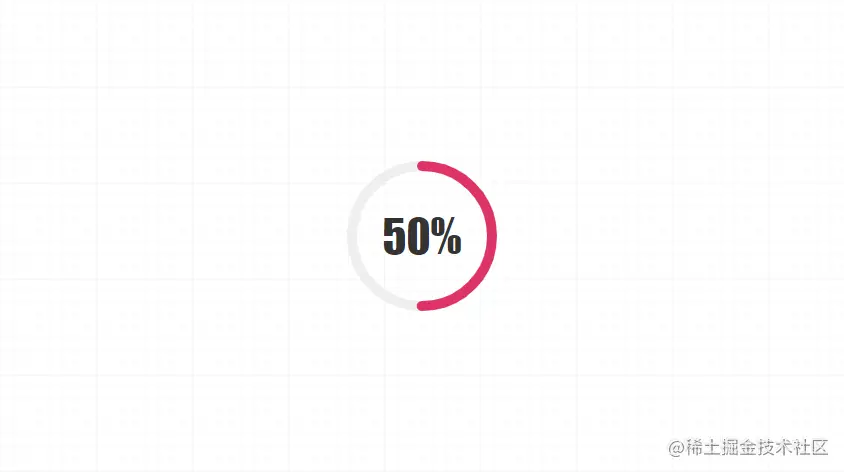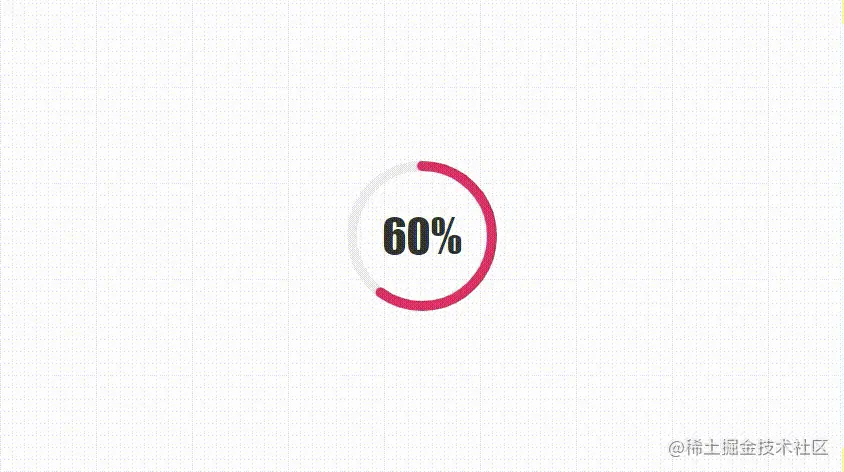Home >Web Front-end >Vue.js >Teach you step by step how to use svg to develop a circular progress bar component in vue2
Teach you step by step how to use svg to develop a circular progress bar component in vue2
- 青灯夜游forward
- 2021-11-05 18:43:382924browse
This article will give you a detailed introduction on how to use svg to develop a circular progress bar vue2 component. I hope it will be helpful to everyone!

We can easily implement the ordinary rectangular progress bar through div css, but the circular one is a bit troublesome. Of course, he can also use div css through the background attribute or clip attribute. It can be implemented with css3 variables as a blind method, but it is too complicated and troublesome to be compatible and controlled. Therefore, to achieve the best effect, we should use svg to achieve it. [Related recommendations: "vue.js Tutorial"]
Let’s start with the final effect of Kangkang:

Develop yourself The advantage of components is that the size, color, thickness, animation, etc. can be expanded arbitrarily. Are you ready? It’s about to start~
Text
1. Participate Calculate
<script>
export default {
name: "CircleProgress",
data() {
return {
now: 0
};
},
props: {
// 进度值
value: {
type: [String, Number],
default: 0
},
// 尺寸
size: {
type: [String, Number],
default: 120
},
// 边框粗细
strokeWidth:{
type: [String, Number],
default: 10
},
// 进度条颜色
color: {
type: String,
default: "rgba(153,202,251,1)"
},
// 动画执行时间
duration:{
type: [String, Number],
default: 1000
}
},
computed: {
percentage() {
return this.value;
},
countDown() {
return this.now;
},
// 圆心x轴坐标
cx() {
return this.size / 2;
},
// 圆心y轴坐标
cy() {
return this.size / 2;
},
// 半径
radius() {
return (this.size - this.strokeWidth) / 2;
},
// 圆周长
circumference() {
return 2 * Math.PI * this.radius;
},
// 进度长度
progress() {
return (1 - this.now / 100) * this.circumference;
}
},
};
</script>I believe everyone will guess roughly how to develop it based on the above comments. Our component can set the size, border thickness, progress bar color, and how long it will take to render from 0. The animation duration of the progress value. As for the calculated attributes, when the SVG is drawn later, it is not difficult to see the purpose based on the one-to-one correspondence in the comments.
2. Structure and style
<template>
<div class="circle-main">
<div class="circle-main-box" :style="[{ 'width': size+'px','height': size+'px'}]">
<svg :width="size" :height="size" class="circle">
<circle
:r="radius"
:cx="cx"
:cy="cy"
fill="transparent"
stroke="#EEEEEE"
:stroke-width="strokeWidth"
/>
<circle
:r="radius"
:cx="cx"
:cy="cy"
fill="transparent"
:stroke="color"
:stroke-width="strokeWidth"
stroke-linecap="round"
:stroke-dasharray="circumference"
:stroke-dashoffset="progress"
/>
</svg>
<span class="count-num" :style="[{ 'font-size': size*.3+'px'}]">{{countDown}}%</span>
</div>
</div>
</template>In fact, this is very simple, just use svg to write two rings, the first one is the gray bottom circle, and the second one is ours Progress bar, set the size and center radius border color, and we need to change the fill color to the same name. We have finished writing the remaining two items stroke-dasharray and stroke-dashoffset. I believe everyone will guess it. The core of the svg progress bar change is These two attributes, which were calculated just now, are the circumference of the ring and the length of the current progress. We use the current progress value to calculate the percentage of the current length and realize the change of the circular progress bar. It is that simple.
Then we still have to write some CSS, and we must write it, because the svg ring does not start from 0 degrees as we think, but is offset by 90 degrees.

So we have to use css to rotate it 90 degrees!
.circle {
transform: rotate(-90deg);
}Then we write some styles of text and main frame.
.circle-main-box {
position: relative;
display: block;
margin: 0 auto;
}
.count-num {
width: 100px;
height: 100px;
position: absolute;
left: 50%;
top: 50%;
margin-left: -50px;
margin-top: -50px;
align-items: center;
justify-content: center;
display: flex;
font-family: fantasy;
font-size: 30px;
color: #333;
user-select: none;
}
#In this way we get a static circular progress bar.
3. Animation and use
<script>
export default {
name: "CircleProgress",
// ...
mounted() {
this.run();
},
methods: {
run() {
if (this.value == 0) return;
let t = this.duration / this.value
this.timer = setInterval(() => {
if (this.now >= this.value) {
return clearInterval(this.timer);
}
this.now++;
}, t);
}
}
};We will calculate the execution time of each quantity 1 through the current animation execution time and the current value, and then execute it through setInterval , until the progress value is reached. Finally, we are about to start using this component~~
<div id="app">
<CircleProgress :value="60" :size="150" :color="'#d36'" :duration="3000" />
</div>
Conclusion
Have you failed in learning? You can do something similar in the future Do you have new ideas for loaders like Completion? With circles as the basis, are you still afraid of other graphics? No matter how much you see or talk about, it is better to try it and act quickly. Come on, everyone, come on~~
For more programming-related knowledge, please visit: programming video! !
The above is the detailed content of Teach you step by step how to use svg to develop a circular progress bar component in vue2. For more information, please follow other related articles on the PHP Chinese website!

